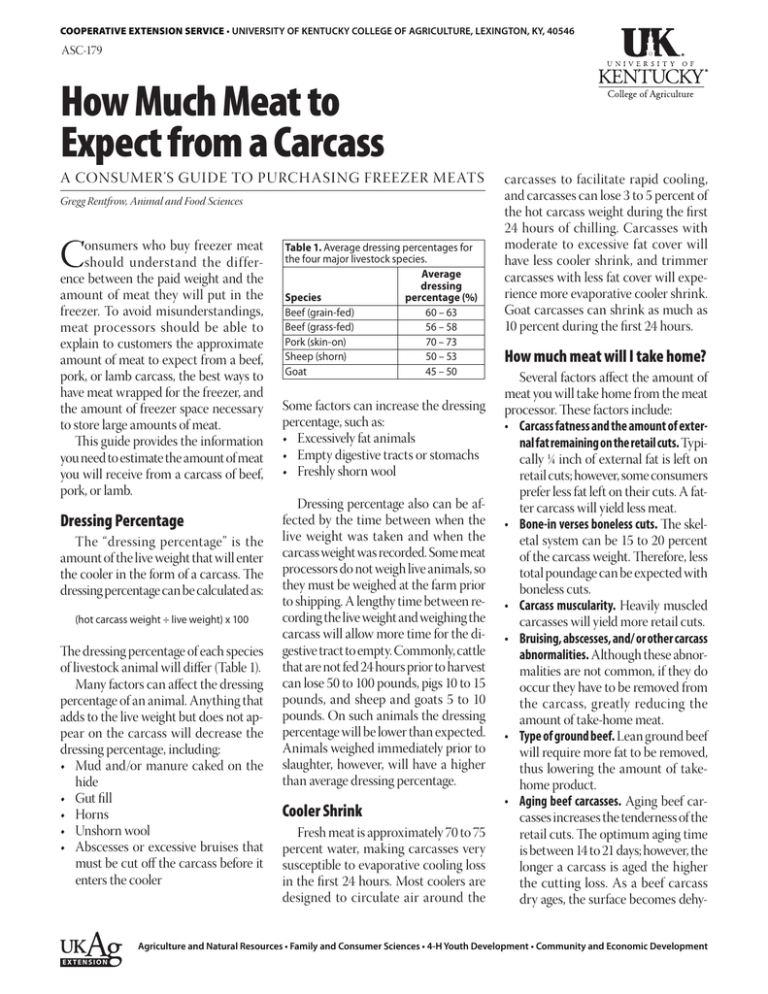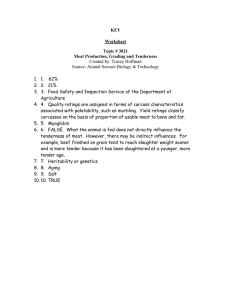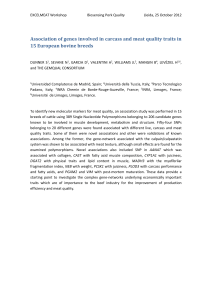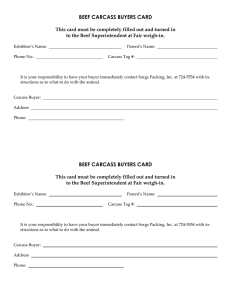ASC-179 - UK College of Agriculture
advertisement

COOPERATIVE EXTENSION SERVICE • UNIVERSITY OF KENTUCKY COLLEGE OF AGRICULTURE, LEXINGTON, KY, 40546 ASC-179 How Much Meat to Expect from a Carcass A CONSUMER’S GUIDE TO PURCHASING FREEZER MEATS Gregg Rentfrow, Animal and Food Sciences C onsumers who buy freezer meat should understand the difference between the paid weight and the amount of meat they will put in the freezer. To avoid misunderstandings, meat processors should be able to explain to customers the approximate amount of meat to expect from a beef, pork, or lamb carcass, the best ways to have meat wrapped for the freezer, and the amount of freezer space necessary to store large amounts of meat. This guide provides the information you need to estimate the amount of meat you will receive from a carcass of beef, pork, or lamb. Dressing Percentage The “dressing percentage” is the amount of the live weight that will enter the cooler in the form of a carcass. The dressing percentage can be calculated as: (hot carcass weight ÷ live weight) x 100 The dressing percentage of each species of livestock animal will differ (Table 1). Many factors can affect the dressing percentage of an animal. Anything that adds to the live weight but does not appear on the carcass will decrease the dressing percentage, including: • Mud and/or manure caked on the hide • Gut fill • Horns • Unshorn wool • Abscesses or excessive bruises that must be cut off the carcass before it enters the cooler Table 1. Average dressing percentages for the four major livestock species. Average dressing Species percentage (%) Beef (grain-fed) 60 – 63 Beef (grass-fed) 56 – 58 Pork (skin-on) 70 – 73 Sheep (shorn) 50 – 53 Goat 45 – 50 Some factors can increase the dressing percentage, such as: • Excessively fat animals • Empty digestive tracts or stomachs • Freshly shorn wool Dressing percentage also can be affected by the time between when the live weight was taken and when the carcass weight was recorded. Some meat processors do not weigh live animals, so they must be weighed at the farm prior to shipping. A lengthy time between recording the live weight and weighing the carcass will allow more time for the digestive tract to empty. Commonly, cattle that are not fed 24 hours prior to harvest can lose 50 to 100 pounds, pigs 10 to 15 pounds, and sheep and goats 5 to 10 pounds. On such animals the dressing percentage will be lower than expected. Animals weighed immediately prior to slaughter, however, will have a higher than average dressing percentage. Cooler Shrink Fresh meat is approximately 70 to 75 percent water, making carcasses very susceptible to evaporative cooling loss in the first 24 hours. Most coolers are designed to circulate air around the carcasses to facilitate rapid cooling, and carcasses can lose 3 to 5 percent of the hot carcass weight during the first 24 hours of chilling. Carcasses with moderate to excessive fat cover will have less cooler shrink, and trimmer carcasses with less fat cover will experience more evaporative cooler shrink. Goat carcasses can shrink as much as 10 percent during the first 24 hours. How much meat will I take home? Several factors affect the amount of meat you will take home from the meat processor. These factors include: • Carcass fatness and the amount of external fat remaining on the retail cuts. Typically ¼ inch of external fat is left on retail cuts; however, some consumers prefer less fat left on their cuts. A fatter carcass will yield less meat. • Bone-in verses boneless cuts. The skeletal system can be 15 to 20 percent of the carcass weight. Therefore, less total poundage can be expected with boneless cuts. • Carcass muscularity. Heavily muscled carcasses will yield more retail cuts. • Bruising, abscesses, and/ or other carcass abnormalities. Although these abnormalities are not common, if they do occur they have to be removed from the carcass, greatly reducing the amount of take-home meat. • Type of ground beef. Lean ground beef will require more fat to be removed, thus lowering the amount of takehome product. • Aging beef carcasses. Aging beef carcasses increases the tenderness of the retail cuts. The optimum aging time is between 14 to 21 days; however, the longer a carcass is aged the higher the cutting loss. As a beef carcass dry ages, the surface becomes dehy- Agriculture and Natural Resources • Family and Consumer1Sciences • 4-H Youth Development • Community and Economic Development EXTENSION drated; the dehydrated surface has to be removed, which lowers the yield. Furthermore, trimmer carcasses (less than 0.3 inch of fat) are more susceptible to surface dehydration, further lowering the yield. Number of Steaks/ Chops and Roasts Tables 2 through 4 detail the total amount of meat to expect from the average carcass. The actual number and amount of steaks/chops, roasts, and ground product will vary from meat processor to meat processor, and how the customer wants the carcass fabricated. Communicate with the meat processor about what you want and understand that some retail cuts are fabricated from others. For example, you cannot expect to get beef Top Loin and Tenderloin steaks (Filet Mignon), if you want T-bone or Porterhouse steaks. Top Loin and Tenderloin steaks are boneless versions of T-bone and Porterhouse steaks. How many pounds will my freezer hold? Make sure you have plenty of freezer space. Most freezers will hold between 30 to 40 pounds of meat per cubic feet. You may need to allow more room for odd shaped cuts. Table 2. Average amount of meat from a 1,200-pound beef carcass. Ground beef Trim Lean Approx. amt. of Cuts (inches) (%) Fat (%) freezer meat (lb) Boneless steaks and roasts 1/8 90 10 425 Bone-in steaks and roasts 1/4 80 20 500 Mixture of bone-in and boneless 1/8 80 20 490 steaks and roasts Boneless steaks and roasts from 1/8 90 10 348 very fat beef animal Boneless steaks and roasts from 1/8 90 10 396 Holstein (dairy animal)* Source: South Dakota State University. Note: Estimations may vary by 25 pounds or more. *A Holstein steer was used in the examples to show how a light-muscled animal will affect the amount of take-home product. Table 3. Average amount of meat from a 250-pound pig carcass.1 Sausage Trim Lean Approx. amt. of Cuts (inches) (%) Fat (%) freezer meat (lb) Bone-in chops and roasts 1/8 80 20 133 Boneless chops and roasts 1/8 80 20 118 Boneless chops and roasts from 1/8 90 10 93 very fat pig 1 Skin-on carcasses. Source: South Dakota State University. Note: Estimations may vary. Table 4. Average amount of meat from a 120-pound lamb carcass. Ground lamb Fleece Lean Approx. amt. of Cuts condition (%) Fat (%) freezer meat (lb) Bone-in chops and roasts, shorn Shorn 80 20 46 fleece Bone-in chops and roasts from a Long 80 20 118 very fat lamb SOURCE? Note: Estimations may vary. Packaging Frozen meat will not last forever in the freezer. The average beef carcass will produce over 500 meals. It would be very difficult for the average American to consume a carcass in a timely fashion. Freezer burn, the dehydration of the frozen meat surface, is a major concern in long-term freezer storage. The type of packaging will help reduce the incidence of freezer burn. Although it may cost more, vacuum packaging retail cuts will help reduce the incidence of freezer burn. Refer to Table 5 for the recommended storage time for frozen meats. Table 5. Recommended storage time for refrigerated or frozen meat. Refrigerator Freezer 38° to 40°F 0° or colder Meat (days) (months) Beef 3 to 4 6 to 12 Ground beef (hamburger) 1 to 2 3 to 4 Pork 2 to 3 6 Fresh pork sausage (without 3 to 4 1 to 2 antioxidants) Lamb and goat 3 to 4 6 to 9 Bacon 7 1 Smoked ham 7 1 to 2 Educational programs of Kentucky Cooperative Extension serve all people regardless of race, color, age, sex, religion, disability, or national origin. Issued in furtherance of Cooperative Extension work, Acts of May 8 and June 30, 1914, in cooperation with the U.S. Department of Agriculture, M. Scott Smith, Director, Land Grant Programs, University of Kentucky College of Agriculture, Lexington, and Kentucky State University, Frankfort. Copyright © 2010 for materials developed by University of Kentucky Cooperative Extension. This publication may be reproduced in portions or its entirety for educational or nonprofit purposes only. Permitted users shall give credit to the author(s) and include this copyright notice. Publications are also available on the World Wide Web at www.ca.uky.edu. Revised 6-2010


